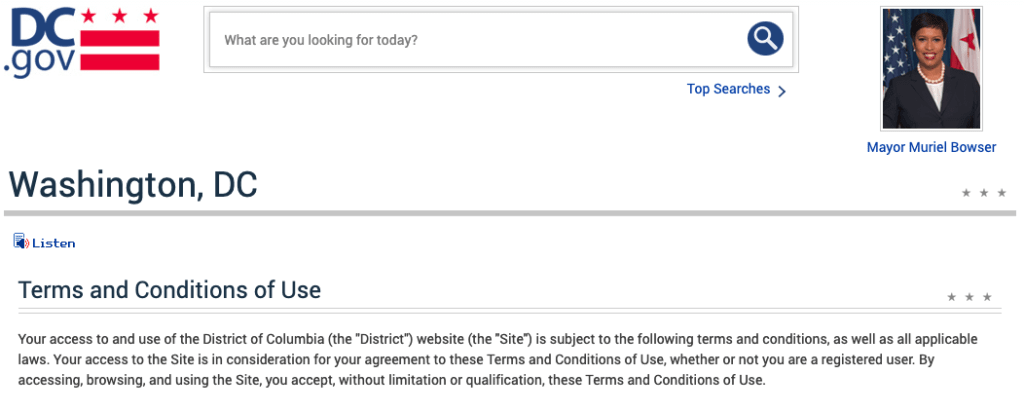The Data Protection Act (DPA) 2018 is the UK's updated data protection law which became effective on 25th May 2018 and was recently amended on the 1st January 2021 to reflect the United Kingdom's exit from the EU. It sits alongside the UK GDPR and replaces the Data Protection Act 1998. The United Kingdom is […]
How to Create your own Terms agreement
Our Terms and Conditions Generator is a solution for you to create the terms and conditions for your website or app. You can download this template by using our terms and conditions generator.

On this page
Generate your own custom Terms and Conditions
Your terms and conditions should be easy to understand and should not be written using any ambiguous language.
What are Terms and Conditions?
Your terms and conditions template document allows you to spell out a set of rules for your users. These set of rules - 'terms and conditions' can be the rules for your services, sales or something as simple as the use of your website. To confirm that your users understand and accept these rules, you must get them to click "Agree".
What should I include in my Terms and Conditions Agreement?
Every business or individual has their own requirements on what they need to include in their terms and conditions. Depending on your business here's a common list of clauses that you may include in your terms and conditions template...
- Introduction
- Specify the scope of your Terms and conditions agreement
- An explanation of the terms you are using in your terms and conditions document
- Usage of the website
- Policy for hyperlinking to your content
- Use of iframes - iframe html tag
- Your policy for allowing or disallowing the penetration testing of your network
- Purchases and other ecommerce related terms
- Returns
- Disputes
- Refunds
- Disclaimers related to the delivery of your services and products
- Guidelines for using your trademarks, license and copyrights
- Your terms around piracy and counterfeit products
- User Generated Content; You must specify your policy on the following (but not limited to) issues
- intellectual property infringements
- anonymous bullying
- Pornographic content
- Feedback & Contact
- Removal of content from your website
Terms and Conditions Template Examples
Below are some terms and conditions template examples specific to the terms mentioned above. If you are looking for Samples, please take a look at our terms and conditions template examples.
Terms and conditions Introduction example
dc.gov's terms and conditions introduction paragraph look like:

Your access to and use of the District of Columbia (the “District”) website (the “Site”) is subject to the following terms and conditions, as well as all applicable laws. Your access to the Site is in consideration for your agreement to these Terms and Conditions of Use, whether or not you are a registered user. By accessing, browsing, and using the Site, you accept, without limitation or qualification, these Terms and Conditions of Use.
Source: dc.gov/page/terms-and-conditions-use
Terms and Conditions Template License example
dc.gov also provides us with an example template for the license clause.
Except for third party content that is copyright protected or for content otherwise noted, content on this site is licensed under a Creative Commons Attribution 3.0 License. Visitors to this site agree to grant a non-exclusive, irrevocable, royalty-free license to the rest of the world for their submissions to DC.gov under the Creative Commons Attribution 3.0 License.
Source: https://dc.gov/page/terms-and-conditions-use
Terms and Conditions - Hyperlinking example
Usually most websites welcome the hyperlinks to and from others as they are beneficial in terms of SEO and gaining visibility on the web. However, there may be conditions where this may be harmful to your or the party you're linking to in one way or the other. For this reason, not only should you include terms that state your terms for hyperlinking to your website but also check the hyperlinking terms of the party you're linking to.
We could not include a screenshot or content for this clause due to the content and hyperlink permission restrictions from the websites this policy was appearing on but you can find some examples of these by doing a google search for: intitle:"Hyperlink Policy"
Terms and Conditions - User Generated Content Example
Terms and Conditions - Feedback and contact Example
You may use this clause to state your terms related to the feedback or the communication of any other form from your customers/users.
Here's an example of how airbnb uses this clause to clarify their terms:
We welcome and encourage you to provide feedback, comments and suggestions for improvements to the Airbnb Platform (“Feedback“). You may submit Feedback by emailing us, through the “Contact” section of the Airbnb Platform, or by other means of communication. Any Feedback you submit to us will be considered non-confidential and non-proprietary to you. By submitting Feedback to us, you grant us a non-exclusive, worldwide, royalty-free, irrevocable, sub-licensable, perpetual license to use and publish those ideas and materials for any purpose, without compensation to you.
source: www.airbnb.com.au/terms
getfeedback.com does something similar:
Feedback. Customer may provide feedback, suggestions, and comments to Company regarding the Services (“Feedback”). Customer hereby grants to Company a worldwide, non-exclusive, perpetual, irrevocable, royalty-free, fully paid, sublicensable and transferable license to use, process, store, edit, modify, aggregate, combine, reproduce, distribute, display, perform, prepare derivative works, and otherwise fully exploit such Feedback in any medium or format, whether now known or later developed.
source: www.getfeedback.com/legal
Terms and Conditions - Returns and Refunds Policy Example
If you have an online store, it is recommended you include a clause for your returns and refunds terms.
Ebay has a dedicated returns and refunds page
If a customer has a problem with their order, or if they change their mind about a purchase, they’ll get in touch with you and ask for help. Once the buyer tells you there’s a problem, you have 3 business days to resolve it.
If an item went missing and never arrived, you need to either provide additional tracking details or offer a resolution, such as a replacement or a refund. If the buyer got their item but it’s faulty, damaged, or doesn’t match the listing description, you need to work with them to resolve their issue (you also have to cover the return shipping costs). If they changed their mind, how you can respond (and who pays for return shipping) depends on your return policy.
Source: www.ebay.com/help/selling/managing-returns-refunds/managing-returns-refunds
You should also state, very clearly in your terms how you go about dealing with the refund requests.
Here's an excerpt from Amazon's refund policy:
Amazon.com and most sellers on Amazon.com offer returns for items within 30 days of receipt of shipment.
Amazon.com Return Policy
Items shipped from Amazon.com, including Amazon Warehouse, can be returned within 30 days of receipt of shipment in most cases. Some products have different policies or requirements associated with them.
Source: www.amazon.com/gp/help/customer/display.html
Asos.com, a clothing retailer gives more specific instructions and states their expectations regarding their expectations on the hygiene, cleanliness and proof of postage. Following is an excerpt but if you own a clothing store, it's a must read.
FAIR USE
If we notice an unusual pattern of returns activity that doesn’t sit right: e.g. we suspect someone is actually wearing their purchases and then returning them, ordering and returning loads – way, waaay more than even the most loyal ASOS customer would order or the items returned don’t match what you ordered – then we might have to deactivate the account and any associated accounts. If this happens to you and you think we’ve made a mistake, please get in touch with Customer Care and we’ll be happy to discuss it with you.
If your account has been deactivated and you need to make a valid return, contact Customer Care. They’ll give you a returns label although you will be responsible for the cost of returning the goods to us.
Please note, we reserve the right to take legal action against you if the items you return don’t match what you ordered.
Source: www.asos.com/terms-and-conditions/
How to create your own terms and conditions?
Head over to our terms and conditions generator to create your own terms and conditions.
Disclaimer
The information in this article is for informational purposes only and should not be construed as legal advice on any matter and does not create a lawyer-client relationship
